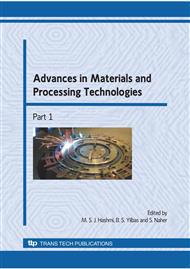p.764
p.771
p.777
p.785
p.793
p.801
p.810
p.818
p.826
Prediction Modelling of Surface Roughness for Laser Beam Cutting on Acrylic Sheets
Abstract:
This paper develops the predicting model on surface roughness of laser beam cutting (LBC) for acrylic sheets. Box-Behnken design based on Response surface method was used to predict the effect of laser cutting parameters including the power requirement, cutting speed and tip distance on surface roughness during the machining. Response surface method (RSM) was used to minimize the number of experiments. It can be seen that from the experimental results, the effects of the laser cutting parameters with the surface roughness were investigated. It was found that the surface roughness is significantly affected by the tip distance followed by the power requirement and cutting speed. Some defects were found in microstructure such as burning, melting and wavy surface. This simulation gain more understanding of the surface roughness distribution in laser cutting. The developed model is suitable to be used in the range of (power 90 to 95, cutting speed 700 to 1100 and tip distance 3 to 9) to predict surface roughness.
Info:
Periodical:
Pages:
793-800
Citation:
Online since:
December 2009
Price:
Сopyright:
© 2010 Trans Tech Publications Ltd. All Rights Reserved
Share:
Citation:


